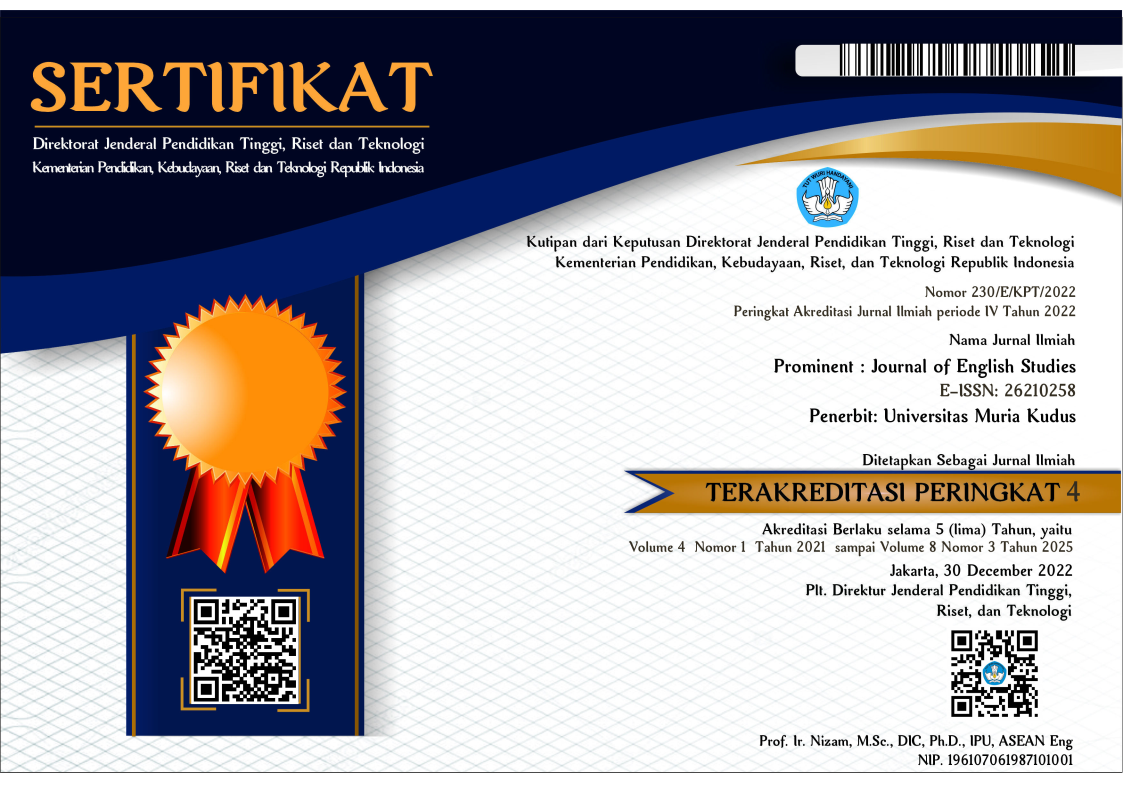KINDERGARTEN TEACHERS’ STRATEGIES TO TEACH ENGLISH VOCABULARY IN A MONOLINGUAL SCHOOL IN AMBARAWA, INDONESIA
Abstract
Living in Ambarawa, which is a small town, an English teacher in such a location has a unique challenge in teaching the target language. This study was conducted at a monolingual kindergarten in Ambarawa, Indonesia. There is one primary question to be answered in this study, which is what strategies were used by English teachers in teaching vocabulary to young learners at a monolingual kindergarten in Ambarawa, Indonesia. Knowing that learning English vocabulary is important, the researchers conducted this research by observing the class ten times and interviewing the English teacher. Class observations, which included the strategies used by the teachers and the learning and teaching process used to collect the data. Besides that, an interview with the teacher was conducted after the class observation to find out the reasons for the teacher in choosing the related teaching strategies. The results of the study presented some various teaching strategies which were used to teach English vocabulary in a monolingual school in Ambarawa. From ten class observations and interviews, three main strategies were identified. The three primary strategies used by the English teacher in a monolingual kindergarten in Ambarawa, Indonesia in teaching English vocabulary to young learners were the use of teaching media, the implementation of appropriate methods and approaches, and the use of fun activities to create a more engaging class. Therefore, given the unique condition of each school, English teachers need to be creative yet wise in choosing the most appropriate teaching strategies to meet the needs of the learners.
Full Text:
PDFReferences
Anjaniputra, A, G. (2013). Teachers strategies in teaching speaking to students at secondary level. Journal of English and Education, 1(2), 1-8. Retrieved from https://www.google.com/url?sa=t&source=web&rct=j&url=https://media.neliti.com/media/publications/191965-EN-none.pdf&ved=2ahUKEwiQvKK8t_fiAhUJPo8KHRC0DRUQFjAEegQIBRAB&usg=AOvVaw0sTlBVy2Iz9BqdeL3ggUM3
Arta, K, H. (2018). The strategies used by English teacher to teach vocabulary (a study at several MAS in Aceh Besar) (Undergraduate’s thesis, Ar-raniry State Islamic University Darussalam-Banda Aceh, Indonesia) Retrieved from https://repository.ar-raniry.ac.id/2964/
Brown, H. D. (2001). Teaching by principles: an interactive approach to language pedagogy. New-York: Longman.
Christen, W., & T, Murphy. (1991). Increasing comprehension by activating prior knowledge. Bloomington: Indiana University.
Gili, N, I, L. & Rochmat, B, S. (2017). Teacher strategies in teaching English vocabulary to young learner. Retrieved from http://onesearch.id/Record/IOS3440.648
Hamruni. (2009). Strategi dan model-model pembelajaran aktif menyenangkan. Yogyakarta: Fakultas Tarbiyah UIN Sunan Kalijaga Yogyakarta
Hashemi, M., & Azizinezhad, M. (2011). Teaching English to Children : a unique, challenging experience for teachers, effective teaching ideas. Islamic Azad University.
Hatch, E. & Brown, C. (1995).Vocabulary, semantics, and language education. Cambridge: Cambridge University Press.
Hubbard & Petter. (1983). A training course for tefl. Oxford: Oxford University Press.
Imaniah, I., Nargis. (2017). Teaching English for young learner. Tangerang: FKIP.
Linse, T, C. (2005). Practical English language teaching young learners. New York: Mc Graw Hill Companies.
Lourenco, O, M. (2017) Developmental stages, Piagetian stages in particular : A critical review. Lisbon : New Ideas in psychology. Retrieved from : DOI: 10.1016/j.newideapsych.2015.08.002
Muhren, A. (2003). Total physical response (tpr): an effective language learning method at beginner intermediate levels. Retrieved from https://www.google.com/url?sa=t&source=web&rct=j&url=https://dokumen.tips/amp/documents/muhren-tpr-primer.html&ved=2ahUK EwiesZLVv4vjAhUEi3AKHdlKB4kQFjAMegQIAhAB&usg=AOvVaw3bEBVOUdTGUCHyQQSf1Qy3&cf=1
Nelson, T. (1997). English nursery rhymes for young learners. Harlow: Addison Welsey Longman. Ltd
Pribilova, L. (2006). Teaching vocabulary for young learners (thesis). Retrieved from Massark University. Department of English Language and Literature. https://www.google.com/url?sa=t&source=web&rct=j&url=https://is.muni.cz/th/npdle/Final_Thesis.pdf&ved=2ahUKEwj3l-eKtLHjAhVbWisKHWTuC-0QFjAEegQIBxAB&usg=AOvVaw2OjxUlubn4f4qrNuOQIeoO
Sadiman & Friends. (1993). Media Pendidikan. Jakarta: Rajawali Press.
Sanusi, E. (2009). The techniques of teaching vocabulary. Kalimantan. Retrieved from https://www.academia.edu/8118721/THE_TECHNIQUES_OF_TEACHING_VOCABULARY
Turnbull, J., Bradbery, J., Deuter, M. (1948). Oxford advance learners dictionary. Oxford: Oxford University Press.
Ur, P. (2012). A course in English language teaching. Cambridge. Cambridge University Press.
Wagner, B. (1989). Whole language: integrating the language arts—and much more. ERIC Digest (ED313675). Bloomington, IN: ERIC Clearinghouse on Reading and Communication Skills.
DOI: https://doi.org/10.24176/pro.v3i2.5203
Refbacks
- There are currently no refbacks.
Prominent Journal of English Studies is licensed under a Creative Commons Attribution-ShareAlike 4.0 International License.
Dedicated to:

in Collaboration with APSPBI:






